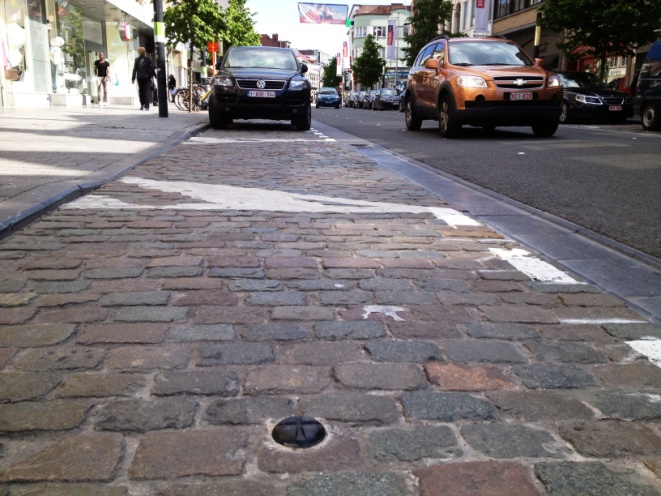
It is the most frustrating part of driving in a city: trying to find a parking space. Did you know that about 30% of all traffic in cities consists of motorists searching for a parking spot? However: new and clever technology is available to make these parking spaces easily findable. This results in less congestion, reduction of emissions and safer streets and thus a more attractive city for visitors and citizens. This technology, developed by the Dutch company Nedap, consists of wireless parking sensors which detect in real-time whether or not a single parking bay is occupied and how long it has been occupied. The parking sensor system is robust and especially designed for parking in challenging on-street environments.
In cities the majority of parking spaces is found on-street. Surprisingly hardly any data on usage of these spaces is available. This is changing rapidly. Many cities and governments, in partnership with the industry, are currently developing and implementing programs to create smarter cities. Parking data from on-street sensors are considered a prominent part of that. With information from parking sensors it is easy to guide visitors, delivery drivers, taxi’s, workers and residents quickly to available parking spaces.

Nedap AVI
For almost twenty years Nedap AVI is considered an expert in advanced and effective solutions for automatic vehicle identification and wireless vehicle detection. SENSIT was introduced in 2006. Since that day Nedap has been focusing on designing the most accurate sensor hardware and the most reliable communication network using wireless sensor nodes. Nedap has designed the solution to be easily integrated with third party systems for parking guidance and traffic management systems, way finding apps and enforcement equipment that are used by major cities all over the world.
On-street parking in cities
As a direct result of over seven years of experience with implementing technology in challenging environments such as the cities of Singapore, New York and Moscow, Nedap really invested in making the sensor network robust and resilient. On-street parking is an integral part of the city’s public infrastructure, which results in a variety of very specific requirements:
- City streets cannot be closed off or badly accessible for many days while the sensor network is installed, since this would have huge impact on the traffic flow in the city. Therefore, any system that has to be installed in a city is required to be easy to install and setup, to be highly scalable and robust.
- As a result of busy streets and high volume traffic movements (from cars, buses, metro, etc.) thousands and thousands of events are generated in the wireless sensor network. Smart filtering and efficient communication protocols should keep the system running even under the most challenging circumstances.
- On-street mounted sensors are continuously exposed to a variety of extreme conditions. The sensor must remain operational under snowy, wet and dusty conditions. Additionally, physical pressure from vehicles, buses and snow plows should not result in sensors failing or breaking.
- Good quality parking data is the core in any effort to optimize parking. Occupancy data from on-street parking sensors has to be set up in a transparent way, should be available in real-time and should support common standards for data integration.
Sensor network platform
Nedap’s parking sensor technology consist of wireless in ground sensors, a communication network and a software application.
Wireless sensors
Every time a vehicle parks in a parking bay, an event with time stamps is generated. The sensor not only measures whether or not a car is parked in that specific parking bay, also the duration of the stay is monitored. The sensor is completely wireless and battery powered. Two types of sensor technologies are used: magnetic and infrared. This dual technology approach ensures reliable measuring. Smart algorithms inside the sensor are used to decide what sensor technology should be used. When the sensor notices that magnetic changes occur, but the infrared sensor is ‘not seeing anything’ after a few attempts, it will conclude that leaves or snow may be covering the sensors and that it would be wise to disregard the infrared sensor and make the magnetic sensor more prevalent.
Communication network
SENSIT uses a multi-hop protocol based on time division. The networking protocol that was specifically developed for this application contains self configuring and self healing elements. The sensors in the ground constantly communicate with each other and, preferable, with relay nodes that are within reach. Relay nodes are used to offer alternative communication paths when the car park is covered in metal from all the cars that are parked there. It also limits the number of hops used for communication, which makes the system much faster and reliable. The communication network is bidirectional. Packages are numbered so they can be retrieved when they are lost. Performing firmware updates inside the sensors is possible by using the wireless network.
The data collector allows bidirectional network communication. A queuing mechanism ensures the network to remain operational, even in case of power failure. Upgrades of sensors or communication network can be realized centrally and every time of the day.
Software application
The data collector transmits the parking status data to the software application. The browser-based-application can be used to configure, monitor and analyze the parking occupancy data. Advanced tools are available for troubleshooting when needed. Standard protocols (like SOAP) are used for integration.

Moving cities forward
With seven years of field experience, Nedap has learned that it takes more than just installing the sensors and operating the communication network to make a project a success. To achieve mobility ambitions, projects will take months or even years to be fully implemented. This requires years of unconditional support and the willingness to be open for collaboration. Furthermore, Nedap AVI presents a sufficient level of business continuity as well as a strong ‘company behind the brand’, which is needed to be able to provide support. Not only today, but even more in the years ahead of us.
In order to answer a city’s smart ambition, an integrated approach on traffic and parking is needed. This requires an open and scalable parking sensor which integrates seamlessly into other systems for parking and traffic guidance, as well as parking enforcement. It may be said: on-street parking in cities may sometimes be somewhat challenging, however the potential impact of wireless sensor networks is enormous.
Ask Nedap for more information and inspiration:
info-avi@nedap.com
0031 (0)544 471 111
www.nedapavi.com



_thumb.png)





